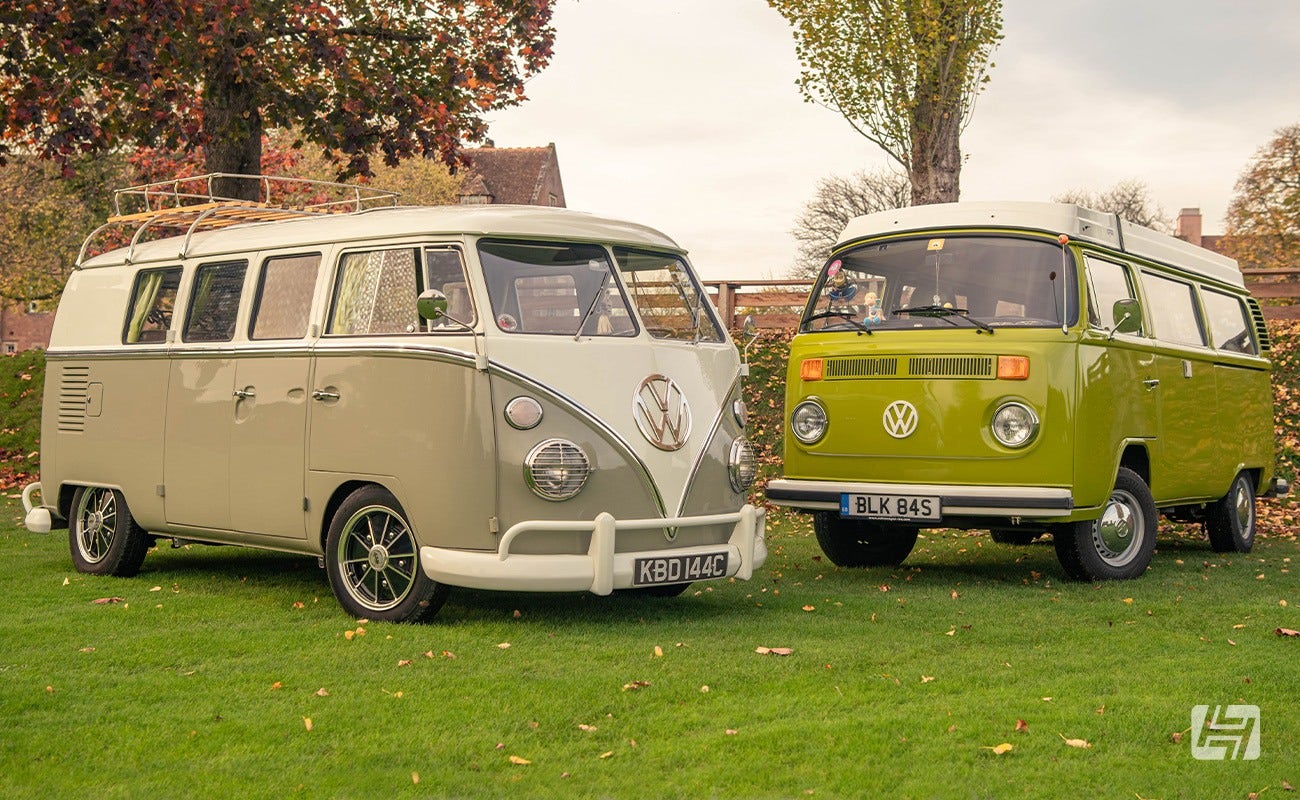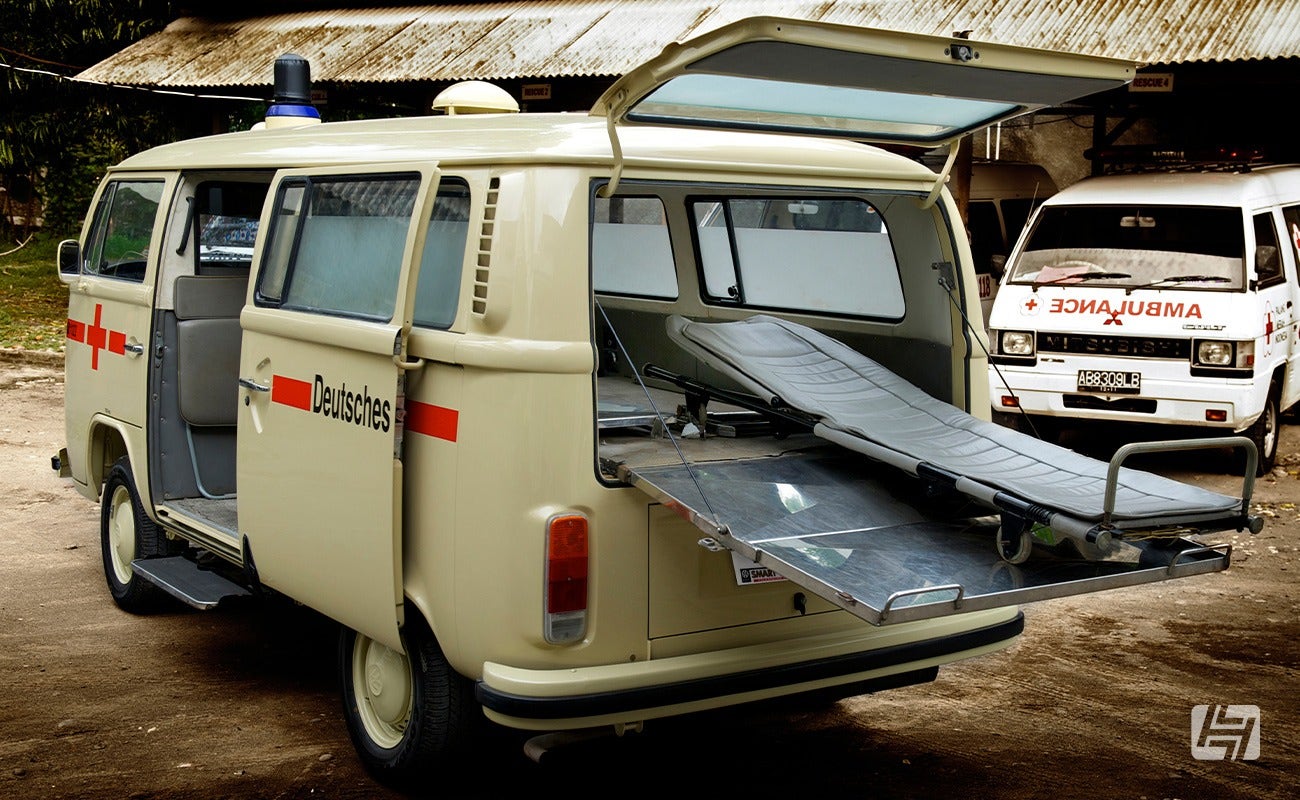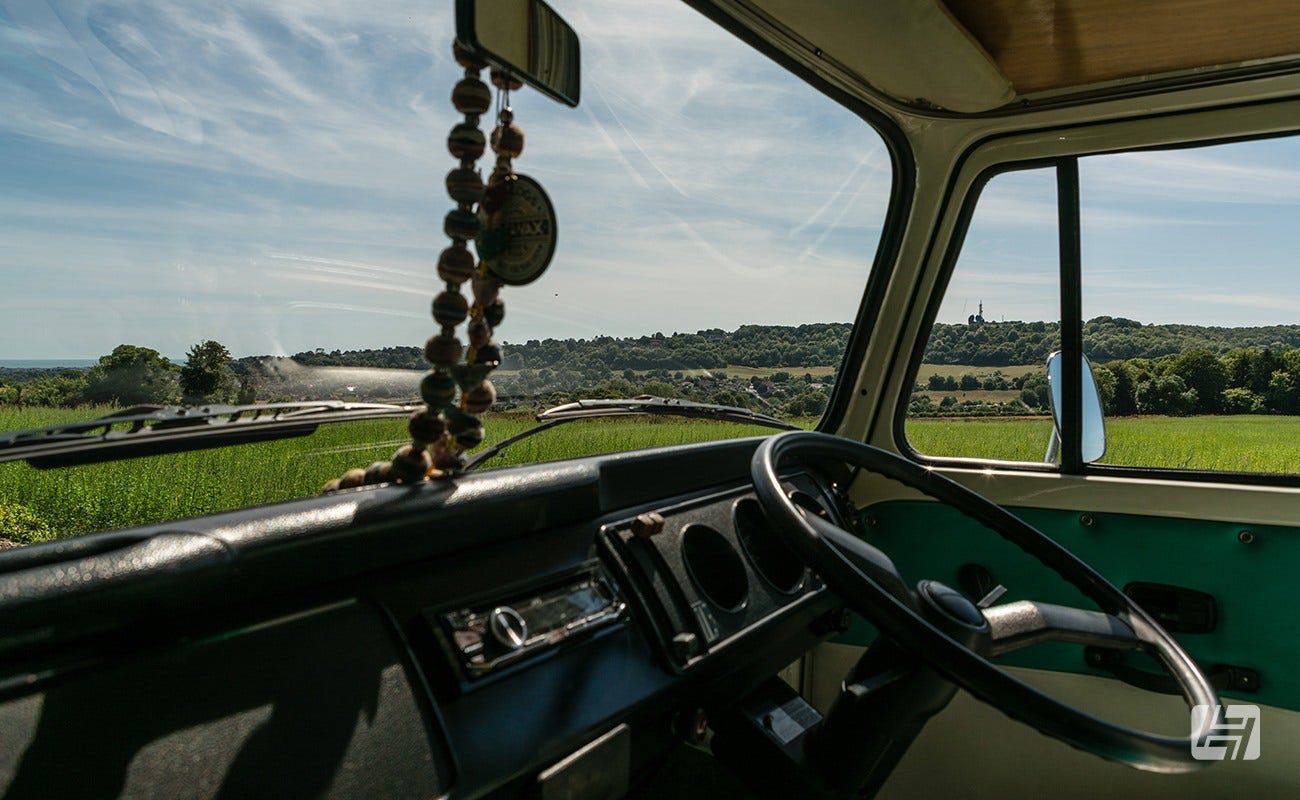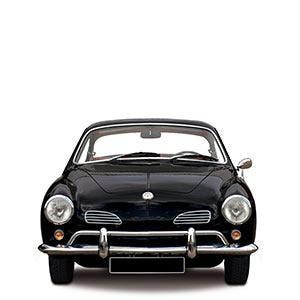The History of the VW Bay Window Type 2
Here's another in our series of model history articles, this time charting the Type 2 Bay Window. We'll follow the story from concept and launch in 1967 right through to when production finished in Germany and then later in Brazil. As always, we'll do our best to triple-check the facts, but if you know something we don't please get in touch!!
If you are looking to buy a VW Bay Window, then check out our Type 2 Bay buying guide here.
The launch of the Type 2 Bay
Following VW’s first incarnation of a commercial vehicle, the Bay Window Bus was introduced in late 1967. Visually quite different from its predecessor, many felt that it had lost some of its character, however, many refinements had been made and its top speed had been increased to an impressive 80 mph.
The distinctive split front windshield may have gone, but the Bay Window was designed to be easier to produce thanks to advances in mechanised production.
The vehicle itself was slightly bigger but considerably heavier than the 'T1' Type 2 it replaced. We commonly refer to this model as the Bay Window, but elsewhere in the world, its nickname is 'Bread Loaf' because of its exterior shape.


What changed between the Split and the Bay?
The new bus design did away with the swing axle rear suspension of the Split and Beetle and the reduction boxes previously used to raise ride height and act as an extra gearbox. Instead, half-shaft axles fitted with constant velocity joints raised ride height without the wild changes in the camber of the Beetle-based swing axle suspension. The updated Bus transaxle is sought after by off-road racers using air-cooled Volkswagen components, as well as being commonly used by Split bus owners when converting their bus to “straight-axles”.
The 36bhp engine in the rear may have grown to 1600cc but remained a single-port design at the time of launch in August 1967.


Type 2 Bay chassis numbers
Unlike the Beetle, the Type 2 was largely a commercial vehicle and was available with a variety of different rear body styles. From single and double cab pick-up trucks to panel vans, minibusses, and full-blown camping conversions, not to mention coach-built motorhomes from the likes of Karmann and Jurgens.
Whilst it is obvious in the case of the pick-up trucks, it is possible to tell what type of vehicle your Bay window started life as from the first 2 digits of the chassis number. This may come in handy if you are looking for an original camper conversion based on a microbus, or to source replacement window seals for your Type 2 project.
- Panel Van had chassis numbers beginning 21x xxx xxx
- Microbus models had chassis numbers beginning 22x xxx xxx for vehicles with a single row of rear seats or 28x xxx xxx for a seven-seat model.
- Kombi models used chassis numbers beginning 23x xxx xxx
- Single cab and Double cab models had chassis numbers beginning 26x xxx xxx
- Ambulance models used chassis numbers beginning 27x xxx xxx
You can also tell the age of a VW Bay bus from the chassis number by studying the third digit which appears after the model designation.
- 1968 (Aug '67-July '68) - xx8 xxx xxx
- 1969 (Aug '68-July '69) - xx9 xxx xxx
- 1970 (August '69-July '70) - xx0 xxxx xxx (note chassis number extended to 10 digits)
- 1971 (August '70-July '71) - xx1 xxxx xxx
- 1972 (August '71-July '72) - xx2 xxxx xxx
- 1973 (August '72-July '73) - xx3 xxxx xxx
- 1974 (August '73-July '74) - xx4 xxxx xxx
- 1975 (August '74-July '75) - xx5 xxxx xxx
- 1976 (August '75-July '76) - xx6 xxxx xxx
- 1977 (August '76-July '77) - xx7 xxxx xxx
- 1978 (August '77-July '78) - xx8 xxxx xxx
- 1979 (August '78-July '79) - xx9 xxxx xxx




Type 2 model variations
We've touched on the different versions above, but it's worth some extra words to clarify the specifications, especially on the full-bodied vehicles which may appear identical at first glance.
- Type 21 Panel Van. The panel van was supplied with two single seats in the cab, and a walkthrough to the cargo compartment. The headliner was only fitted in the cab area, and the cargo area was very spartan, with no side panels, heating, or windows. The spare wheel was stowed in the engine compartment.
- Type 22 Microbus. Fitted with softer rear torsion bars for a bit more passenger comfort, and chrome hubcaps. The cab was much the same as a panel van, but the headliner extended full length, and the glovebox had a lid. The passenger compartment was fitted with two three-seater bench seats and the interior panels had upholstery.
- Type 23 Kombi. This was a combination of a panel van, and a microbus, hence the name. Inside, the headliner was fitted in the cab area only, and just one heater outlet into the cargo area where rear seats were fitted from the factory. Externally, there was 1 vent window in the sliding door, and 1 window in the opposite side panel but none in the rear side panels. Stronger torsion bars were fitted on all years, except for the 1968 models.
- Type 24 Micro Bus L. Essentially the same as Type 22, but with added M-codes (optional extras). The Deluxe bus had the following options available over the standard microbus; steel sliding sunroof (until 1974), dash-mounted clock, vent windows in the doors, bump strips on the bumpers, jail bars on rear and side windows, a chrome set (including badges, window trims and a belt-line trim) and trim rings on the windows. In 1974, the Type 24 moniker was dropped, and the Deluxe became an M-coded variant of the Type 22.
- Type 26 Pick-Up. Available in two styles. Single Cab. This had one cargo door under the pick-up bed, metal dropsides, and a spare tyre stored under the bench seat. The cab featured a single seat for the driver, then a 2 seater bench seat alongside it. Twin Cab. These had the same single and double seat configuration for the front of the cab, then a 3-seater bench in the rear. The spare tyre was stored under the rear bench seat. Externally there was a single door to a cargo compartment below the pickup bed on the passenger side. Side panels were made from fibreboard side panels, and there was only one heater outlet to the rear of the cab.
- Type 22 Ambulance. These were not dissimilar in base specification to a Type 22, but with the addition of a bulkhead (with sliding window) between the cab and the passenger area, the spare tyre was located under the bench seat in the cabin. Reverse lamps were standard on all Ambulances, along with chrome hubcaps and a searchlight fitted to the inside of the windscreen. On the inside of the rear compartment, the headlining was extended to meet the top of the trim panels, which were ivory in colour. A roof ventilator was fitted, and an adjustable heater nozzle was fitted. The windows are all fitted with blinds or frosted from halfway down for patient privacy and softer rear torsion bars were fitted for comfort.




VW Type 2 M-Numbers
M-Numbers are VW’s way of distinguishing optional equipment, for instance, M020 was a speedometer in MPH, and M032 was a lockable fuel cap.
M524 was a variable option, but basically covered all the options that would have been standard fit on US and Canadian spec vans. This list included padded dashboards, side markers, all-red taillights, twin filament bulbs in turn signals, ignition key warning buzzer, dual circuit brake warning lamp, illuminated heater controls, chrome trim on all Microbuses, and sealed beam headlamps.
Interestingly US spec pickups had two oval-shaped slots in the tailgate allowing the rear lights to show through even when the tailgate was dropped.
Today, VW uses PR-Codes to define the specification of each vehicle.


Evolution of the early Bay
By February 1968 VW had already started making changes to the Bay Window model, with the hazard warning light switch changing, and a firewall installed between the fuel tank and the engine.
In 1969 more changes happened. The cab doors were now lockable from the inside via a small catch above the door release as opposed to the vertical pins of the previous model. The external door handles were changed from a push-button type to a trigger type. There was also a small number of electrical and detail changes.
The 1970 model year saw more significant changes take place in the name of safety. The painted dashboard was swapped for a black padded version for all markets, previously it had been painted except in the US, which had padded dashes from day 1.
The dashboard top was also changed so it was level across its width, not raised at the steering wheel. Window winder handles and door release handles became black plastic on all models except the Deluxe and US models had the side markers changed from round to rectangular.




The cross-over years
1971 saw the introduction of the twin port 1600cc engine, which featured dual intake ports on each cylinder head. This meant an increase of power to 50bhp, and coincided with the addition of new vented road wheels (now 5x112 PCD rather than 5x205 PCD) behind which VW had fitted disc brakes for the first time on the Type 2.
On the body, and visible in the side shot above you will notice the 'half moon' vents on the rear corner panel, and also the fuel flap above the rear wheel. Both of these styling cues changed for 1972 with the rear vents becoming rectangular and the filler flap moving further rear on the side panel so it could be accessed whilst the sliding door was open. The removable rear valance for accessing the engine became permanently fixed and the rear wheel arches were given a larger lip to allow more clearance for the new wheels.
Whilst the front of the Cross over Bay kept the low front indicators and more rounded ventilation grille, the rear of the bus was updated with much taller tail lights.


The late Bay
The late Bay models had a more defined styling update with the indicators moving higher up the front panel and chunkier Europa bumpers, with the front mounted on a deformation panel. This bulge below the headlamps was a safety-led refinement and was designed to crumple in the event of an accident to help absorb the impact. Eager eyes would also note the badge shrunk overnight and was now formed of plastic, rather than metal.
The front wheel arches were similarly flared from 1973 to better match the wider rears from the year before. At the back, the larger rear lights with integral reverse bulbs were joined by a matching Europa-style bumper and the engine lid was changed to feature a squarer number plate aperture, along with a new locking mechanism and handle.
Whilst Europe would see it as an option alongside the 1600cc Type 1, the US VW fitted the larger but flatter Type 4 engine to all models from 1972 onwards. Initially, in 1700cc capacity with 65bhp, it later grew to 1800cc (67bhp) then finally 2000cc (69bhp) in 1976. Both the Type 1 and Type 4 engines now came equipped with alternators.
The Type 4 engine was so-called as it had originally been designed for the 411 and latterly the 412, VW’s attempt at an air-cooled family saloon or estate car, in the late 60s and early 70s. It was also used in quite a few other vehicles as well, including the Porsche 914, and the Porsche 912E models, as well as being used in the Bay’s successor, the T25. It was the basis for the 1900cc and 2100cc water boxer engines as featured in the Type 25.
1973 was the first year that Volkswagen offered an automatic gearbox in a commercial vehicle, however, this did shave a few horsepower off the performance figures.
In 1974 the sliding door handle was changed and now featured the lock in the door, as opposed to the handle, making it possible to lock the door from the inside but still unlock it from the outside. The fuel filler flap made way for a more simple flush-mounted filler cap and for ease of access, VW introduced an inspection cover above the engine, in the form of a lifting luggage compartment floor.
1975 and 1976 saw relatively little in the way of changes for the bus, with only minor changes occurring, the previous stainless steel mirrors had been replaced by painted steel items on all but the Deluxe models. The Type 4 engined bus had a capacity increase from 1800-2000cc and was also now offered in Type 26 pick up models.
In the last three years of production, the Bay saw little in the way of updates, VW was busy working on the Type 25 (the Bay’s successor). Externally the engine lid hinges were changed to a more simple design, but internally, mechanically, and electrically it was largely untouched.




The CKD Type 2 Bay
VW had the perfect opportunity to launch the Bay Window into developing markets, but a lot of these countries had laws in place making the import of luxury items, such as cars and vans prohibitively expensive.
VW had an answer for this in the form of CKD vehicles (Completely Knocked Down Kits). In short, this consisted of a giant Airfix kit, and the vehicles being supplied in kit form, grouped into various modular parts, packed in easily transportable packing cases, and ready for easy assembly upon arrival. CKD vehicles were only available as basic models, such as Kombi’s, Pick-ups and Panel Vans. The luxury transporters were deemed too complex to assemble outside of a main VW factory.
The CKD kits were assembled at specially commissioned plants in the following countries; Indonesia, Thailand, Philipines, Malaysia, Pakistan, Peru, Sri Lanka, Finland, Senegal, Turkey, Egypt, Ecuador, Mexico, Ghana and Kenya.


Brazilian built Bays
Full production of Type 2’s in Brazil commenced on the 2nd of September 1957, at VW do Brazil’s plant in Sao Bernardo do Campo, just outside Sao Paulo. However, CKD Splitscreen kits were being produced in the factory from 1953 and around half the parts necessary for production were already being made locally or by VWB anyway, so it was a small step to move total production over. Brazilian-built buses were not only sold in the home market but also in South and Central America as well. Unlike in Europe, Split window buses were produced in Brazil up until 1975, when VWB began production of the Bay bus using T1 and T2 parts.
Whilst from the front the buses looked nigh on identical to their German cousins, the bus from the B pillars back bore more resemblance to the Split. The Brazilian-built Bay had a 15 window split type rear end with a narrow tailgate, and corner windows, along with late spec Bay rear lights; it's a real mix-and-match affair! This 'cobbled-together' trend was also continued for the panel van, which featured double-opening cargo doors, rather than the sliding door we’d become accustomed to on the European model. Production of these hybrid buses continued up until 1997, in the form of Panels, Kombi’s, and Single and Double Cab pickups.
In 1981 VWB introduced a new 1600cc diesel for the Bays based on the Mk1 Golf Diesel engine, however, this was offered only on the panel van, single cab, and the newly introduced double cab pickup.
In 1983 the Brazilian buses were brought up to c.1973 European model specification with the addition of disc brakes and seat belts. 1985 saw the diesel and double cab models axed and in 2000 the pickup was removed from the lineup completely too.
In 1997 VWB announced the new Kombi, which apart from a slightly raised roofline, a new steering wheel, and some other minor changes is almost the same as a European spec Bay. Two engine options were available. The first was fuelled by Methanol, the other being the venerable Type 1 1600cc aircooled unit. These revised Type 2 vehicles were available in 5 different configurations; School Bus, Panel Van, Kombi Minibus, Kombi, and an Ambulance version. The Kombi could only be ordered in white, but once every two months, one day’s worth of production was finished in Silver.
Taking around 40% of the light commercial market the Kombi proved massively successful in Brazil, with its low prices (around 6500 Euros for a new one) representing great value. Aircooled production ended on December 23rd, 2005 with a new “Total-Flex” engine taking its place. Originally designed for the local market 'VW Gol' it is similar to our VW Polo 1400cc watercooled inline 4 cylinder unit. These engines produce around 79bhp on pump petrol, and around 80bhp when run on ethanol, which is easily available in Brazil as it is a product of refined sugarcane. To allow for both fueling methods, the vehicle has to be fitted with two fuel tanks (one on each side). The 'extra' ethanol tank was often removed by converters when imported outside of South America. Find out more about the Kombi models in our buyers guide.
With a less visually pleasing, large radiator grille mounted on the front, the water-cooled VW Kombi’s sadly lack some of the aesthetic of the older vehicles. They were, however, produced in Brazil up until 2013, when the last 'traditional' Transporter left the factory on 31st December. This special vehicle is now kept in a museum at Volkswagen's Commercial factory in Hannover and marked the end of the rear-engined, Transporter era; outlasting both the Type 25 and the T4 that succeeded it in Europe.






Mexican Kombis
VW de Mexico produced the first Type 2s for their home market on October 1st 1971, in Puebla, one of Volkswagen's largest overseas manufacturing plants. From initial production, the Bay was available in both Kombi (called Combi in Mexico) and Panel van (Panel) specification in Mexico.
During a 25-year production period, VW Mexico produced 250,000 Type 2’s. The Mexican Bay went through a similar development process to that of the Brazilian equivalent, with a water-cooled motor being offered in 1987, and the roofline changing to a more elevated design in 1991. Externally there were a few differences from their Brazilian counterpart. Note the deeper front bumper and different profile and extra long sides on the rear bumper, we've also seen versions with an updated dashboard with the lower half much more enclosed.
In 1996 production of the Bay in Mexico ceased, and up until VW decided to discontinue the Type 2 in Mexico in 2001, all remaining buses were manufactured and imported from Brazil before being sold.


Whilst we are sure to have missed something, we've learnt a few things compiling this Type 2 history article and we hope you find it useful to. Know something we don't? Drop us a comment below.
Andy




 Beetle
Beetle
 Karmann Ghia
Karmann Ghia
 Type 2 Split
Type 2 Split
 Type 2 Bay
Type 2 Bay
 Type 25
Type 25
 Transporter T5
Transporter T5
 Golf Mk1
Golf Mk1
 Golf Mk2
Golf Mk2


 911
911
 996
996
 997
997
 986 Boxster
986 Boxster
 987 Boxster
987 Boxster
 912
912
 944
944
 924
924


